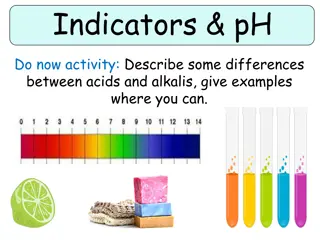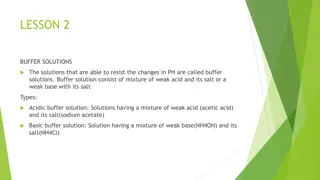Understanding Buffer Solutions and pH Indicators
Buffer solutions resist changes in pH upon the addition of acids or bases, maintaining a stable pH level. They consist of a weak acid and its conjugate base or a weak base and its conjugate acid. pH indicators are weak acids or bases that exhibit color changes based on their degree of dissociation at different pH levels. By learning about buffers and pH indicators, you can better understand how pH is controlled in various solutions.
Download Presentation

Please find below an Image/Link to download the presentation.
The content on the website is provided AS IS for your information and personal use only. It may not be sold, licensed, or shared on other websites without obtaining consent from the author. Download presentation by click this link. If you encounter any issues during the download, it is possible that the publisher has removed the file from their server.
E N D
Presentation Transcript
Buffers: are compounds or mixtures of compounds that, by their presence in solution, resist changes in pH upon the addition of small quantities of acid or alkali. buffer action : The resistance to a change in pH .
What is a Buffer? A combination of a weak acid and its conjugate base (i.e., its salt) or a weak base and its conjugate acid .
Consider a buffer solution that includes of a weak acid and its salt such as the acetate buffer: CH3COOH H3O+ + CH3COO (incomplete dissociation) (complete dissociation) CH3COOK K+ + CH3COO
When a strong acid, such as HCl is added, the following takes place: HCl H3O+ + Cl CH3COOH H3O+ + CH3COO CH3COOK K+ + CH3COO The increase in hydrogen ion causes a shift to the left and more CH3COOH is formed since there is a sufficiently high [CH3COO ] (it will tie up the hydrogen ions)
When a strong base, such as KOH is added, the following occurs: KOH OH + K+ CH3COOH H3O+ + CH3COO (shifts to the right) CH3COOK K+ + CH3COO The added OH ions react with the H3O+ ions to form H2O The decrease in [H3O+] causes a shift to the right and more CH3COO is formed. And almost all of the added OH is used up.
PH Indicators Indicators may be considered as weak acids or weak bases that act like buffers and also exhibit colour changes as their degree of dissociation varies with pH (1-12). For example, methyl red shows its full alkaline colour, yellow, at a pH of about 6 and its full acid colour, red, at about pH 4.
Range and Color Changes of Some Common Acid-Base Indicators pH Scale 1 2 3 4 5 6 7 8 9 10 11 12 13 14 Indicators Methyl orange red 3.1 4.4 yellow Methyl red red 4.4 6.2 yellow Bromthymol blue yellow 6.2 7.6 blue Neutral red red 6.8 8.0 yellow Phenolphthalein colorless 8.0 10.0 red colorless beyond 13.0 Bromthymol blue indicator would be used in titrating a strong acid with a strong base. Phenolpthalein indicator would be used in titrating a weak acid with a strong base. Methyl orange indicator would be used in titrating a strong acid with a weak base.
H+ Phenolphthalein Indicator Colorless = Acidic pH Pink = Basic pH
The colour of an indicator is a function of the pH of the solution. The dissociation of an acidic indicator is given in simplified form as:
HIn is the un-ionized form of the indicator, which gives the acid colour, and In- is the ionized form, which produces the basic colour. If an acid is added to a solution of the indicator, the hydrogen ion concentration term on the right-hand side of equation is increased, and the ionization is repressed by the common ion effect. The indicator is then predominantly in the form of HIn, the acid colour.
If base is added, [H3O+] is reduced by reaction of the acid with the base, reaction proceeds to the right, yielding more ionized indicator In-, and the base colour predominates. Several indicators can be combined to yield so-called universal indicators just as buffers can be mixed to cover a wide pH range (red-purple).
B : small increment in gram equivalents/Liter strong(base ) added to the buffer soln. to produce a pH change of pH of
Factors affecting on buffer capacity:- [Salt]/ [Acid] ratio total concentrations of acid and salt .
Various buffer systems have been suggested for different pharmaceutical solutions: Sorensen phosphate Acetate buffer
Experimental work Part l: prepare 0.2 M HAC, ( solution A) 0.2 M NaAC (Solution B) 0.1 M NaOH.
Part III measuring the PH,using PH meter: Put the electrode of the PH meter in the buffer solution & read the PH. Take a certain volume of acetate buffer solution; add sodium hydroxide portions (0.1 ml of 0.1 M) to it. Then, measure the PH and calculate the buffer capacity.























